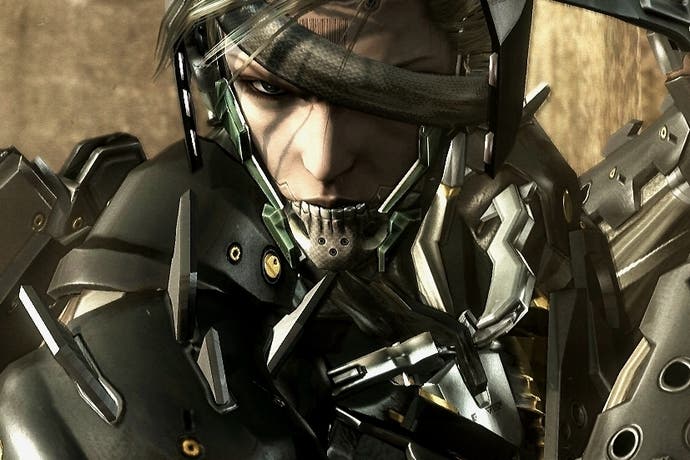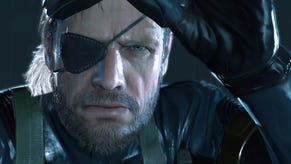Face-Off: Metal Gear Rising: Revengeance
Blade storm.
It's been an unusually rocky road for a Metal Gear project, but with Platinum Games' capable coders and designers taking the mantle from Kojima Productions, Rising has at last broken away from the threat of development hell and gone gold for both PS3 and 360. With the swift change of developer, we also see a major shift in approach to its design specifics, especially compared to the game's original unveiling at Microsoft's E3 2009 conference. Where before we had the "Zan-Datsu" slicing mechanic weave into a slower-paced, stealthier game locked to 30FPS, we now have in its place a frenetic 60FPS action title built in a mould closer to that of Bayonetta's - though with key uses of the original slicing concept.
This bullet-point mechanic allows Raiden to slice through object geometry to generate tinier, independent chunks - ranging from incidental objects such as crates, to giant bridge structures with multiple supports. Implemented by Platinum Games' system programmer Tsuyoshi Odera, the system as it appears in the final game has no direct link to the one seen in Kojima Productions' original E3 demo. He explains that "at first, our engine wasn't capable of doing something like cutting through an opponent anywhere. I looked at official trailers and other game data from Metal Gear Solid: Rising and tried to make our engine fit with what I saw." Due to memory constraints on both consoles, it also proved necessary for the speed of Raiden's slicing animations to be carefully measured while in this mode, avoiding too many chunks being created in quick succession.
As such, Metal Gear Rising: Revengeance is designed from the ground up through Platinum Games' in-house engine, and as with Vanquish, PS3 serves as the lead platform here. Our tentative analysis of the demo code showed great promise in taking this approach, with the only notable differences between the PS3 and 360 versions being the higher quality video assets on Sony's platform, and the lack of v-sync for the Microsoft sampler. Other contrasts included the use of a percentage closer filtering (PCF) technique on PS3, resulting in rougher looking shadows from a distance, but otherwise it turned out to be a close call indeed.
To see if the margin has narrowed at all in the ensuing months of development, we put the final PS3 and 360 releases to the test, each with the launch day 1.01 patch installed. To focus on the image quality side of the equation first, we compare the two versions with matching clips in our head-to-head video below, supplemented by a hefty comparison gallery.
"Xbox 360 owners concerned at the screen-tear in the demo can rest easy - the final game engages v-sync and still runs more smoothly than the PS3 version."
Right off the bat, as far as image quality is concerned we see each platform turning in a crisp 1280x720 native resolution, albeit with no anti-aliasing applied over the top. The set-up calls to mind Bayonetta on 360, and though jaggies are easy to pick out when deliberately scouting for long edges, the issue isn't apparent when the combat moves as quickly as it does here. Otherwise, the presentation of the game's many video cut-scenes is aided by having AA running through the original render, producing a markedly more polished look whenever the story is being pushed forward. A PC release would stand to put these artifacting niggles to rights, of course, but plans to develop such a version of the game are still up in the air.
As far as core assets are concerned, we're looking at the same package between the two console formats; texture quality and filtering cascades are identical, and level of detail (LOD) transitions occur in synchrony when Raiden paces forward in matching clips. This applies to objects such as trees and cars, which swap in higher-poly models based on the character's proximity to them - though we're hard pressed to catch this switch-over by eye. Even particle effects and alpha buffers are a match here, with flickers of lightning, dust clouds and friction sparks constantly flaring up around Raiden's every footstep.
Once again, the biggest distinguishing point comes down to video quality. Set-pieces are rendered purely in-engine, while the majority of cut-scenes are provided by means of pre-rendered footage, with the PS3 coming across as visibly sharper overall. Due to a heavier compression algorithm, sequences with lots of motion cause macroblock artifacting to flare up on 360 and even in the best case scenario we see a blurring over of fine details. The difference in disc sizes speaks for itself; the PS3's Blu-ray is occupied by 18.2GB of video files, compared to the 5.3GB video directory we see on the 360's DVD. The PS3 streams these higher bit-rate files directly from the disc as needed, with the only caveat being that the core data archives (weighing in at a total 2.2GB) need to be installed to the HDD on first boot. In all, it's a worthwhile compromise for Sony's platform that services a much better looking game in this respect.



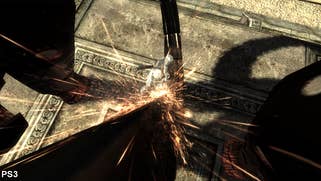
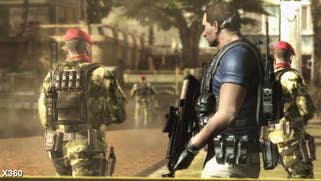

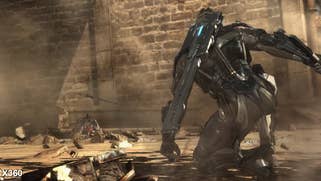
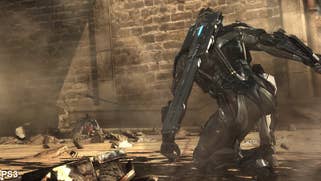
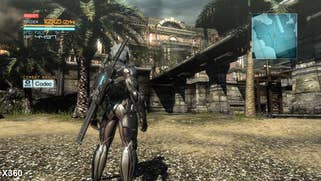

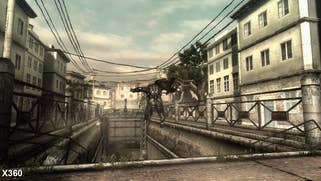

Shadow filtering quality and draw distance are two other points of contention in this release. Certain shadows are missing entirely from the 360 version, for example, including the dithered self-shadow at Raiden's feet during VR missions and those cast in the far distance of the opening Abkhazian beach stage. The differences in filtering are also curious; the 360's appear permanently dithered regardless of your proximity to them, while the PS3's PCF approach - which varies in quality depending on which side of the cascade they fall on - leaves distant shadows looking far more pixellated overall.
Though Metal Gear Rising shows brief flourishes of visual flair, such as the haze effect towards the horizon of the early beach stage, much of the game's look is pared back to support its 60FPS target. The result is that the game's overall aesthetic can come across as a tad plain when scrutinised too closely, especially against more cinematic games targeting the 30FPS benchmark - God of War: Ascension being one example, with its beautiful per-object motion blur. Even so, the support of a complex physics engine does mitigate the grainy wall textures and lack of anti-aliasing to an extent, and in motion these issues are made less prominent.
Metal Gear Rising: Revengeance - performance analysis
The decision to hinge Metal Gear Rising's design around a 60FPS target refresh sits very well with action titles in this tradition, where parrying enemies needs to be judged down to a tight window of frames on higher difficulties. The only issue here is that the demo code showed both PS3 and 360 struggling to fully deliver on that promise, with Microsoft's platform dropping v-sync regularly as well. With final code in our hands, we can finally test out synchronised in-engine cut-scenes on both platforms to see whether this is still the case, and to get an idea of how performance stacks up between each version in like-for-like settings.
"Comparisons of like-for-like traversal and cut-scene sections show anything up to a 10FPS advantage for the Xbox 360 version of the game."
The big surprise is that the abundant tearing found on the 360 demo has been quelled for the final release, meaning both platforms hang on to v-sync, for better or worse. This flies in the face of convention given the studio's approach to Bayonetta, which does a much better job of holding on to its silky smooth 60FPS feedback through use of an adaptive v-sync - allowing frames to tear where necessary. Even so, the benefits to the 360's overall image quality are substantial, and v-sync remains with the dashboard set to 1080p too (we heard some reports of excessive tearing here on the demo).
The frame-rate during scripted quick-time events, such as one slide down a mountain-side during an avalanche, shows us a clear 360 performance advantage over PS3 during synchronised play. The clearance is typically by a matter of 10 frames per second, where Microsoft's platform is holding the higher ground consistently throughout our tests. One very early cut-scene involving Metal Gear Ray gives us our lowest reading overall, where Raiden chopping its exoskeleton to pieces causes the PS3 to dip down to 28FPS, while the 360 version drops to a marginally smoother 32FPS.
This isn't an issue for scripted scenes, given that player input basically boils down to mashing a single button to proceed. However, similar results during open battle affect the run of play more drastically. In comparing eight different combat scenarios, we see the frame-rate wavering between 40 and 60FPS marks on both consoles with the 360 typically ahead of the two. The only exceptions to this rule occur while using blade mode, where the 360 chugs down to as low as 18FPS while slicing two enemies at once. Given that the frame-rate varies so regularly for each version, the perceived effect is that both platforms judder in equal amounts when the game's physics engine involved, or where multiple explosions flare up on-screen.
"Both versions feel very similar in general gameplay, occupying a highly variable 40-60FPS performance level depending on the intensity of the action."
Metal Gear Rising: Revengeance - the Digital Foundry verdict
All in all, credit is due to Platinum Games for salvaging the most intriguing ideas from Kojima Productions' original E3 demonstration and delivering a Metal Gear title infused with its signature brand of over-the-top action. Though we'll have to wait until Ground Zeroes to see the much-touted Fox Engine put to practical use, there's plenty to admire in the tech at work here. The Zan-Datsu mechanic works just as it was pitched four years ago with everything from bridges to Ferris wheels collapsing based on the momentum and angle of your slice, and with a potentially infinite number of ways to divide every enemy and object.
The pressing issue remains that the game's physics engine takes a major toll on current console hardware. When pushed too far, frame-rates on both the 360 and PS3 come tumbling down to 30FPS at points - and potentially lower once we dice up more than a single object in one go. As a result, we rarely get a look-in on the 60FPS dream during combat. Although the 360 consistently betters the PS3 from a performance standpoint, both versions are ultimately stuck in the juddering 40-50FPS no-man's land - albeit with v-sync thankfully engaged on each.
As far as image quality goes, the gap between the PS3 and 360 releases has narrowed since the demo first landed, with identical textures, native resolutions and effects on showcase for each. The differing approaches to shadow filtering brings out unique rough edges on either platform, but the nature of this is variable and dependent on the positioning of the camera during gameplay. Crucially, however, the PS3 offers the highest quality cut-scenes, owing to superior video compression afforded by the Blu-ray format. These are perceptibly clearer, and sidestep the evident macro-blocking we see in motion on 360.
In the final call, both versions of Metal Gear Rising: Revengeance are well worth considering, with each fronting unique advantages. Call it a tie overall: the performance nod goes to the 360 rendition of the game, often running with a 10FPS lead, while image quality purists are strongly advised to seek out the crisper PS3 version.
